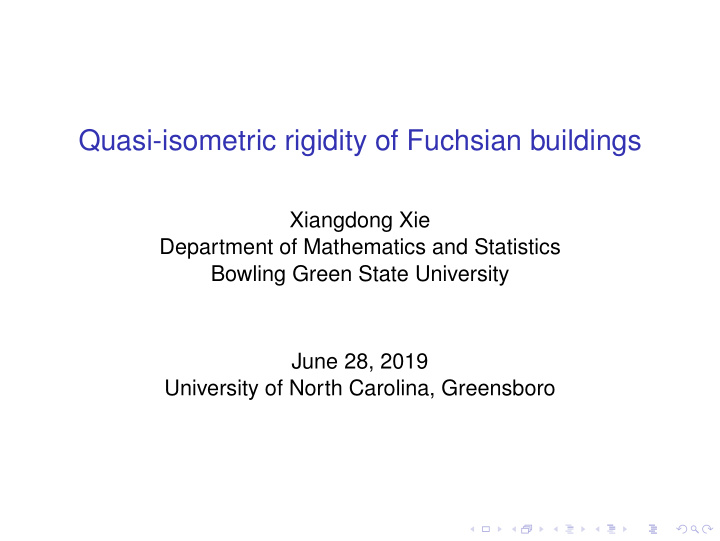



Quasi-isometric rigidity of Fuchsian buildings Xiangdong Xie Department of Mathematics and Statistics Bowling Green State University June 28, 2019 University of North Carolina, Greensboro
Quasi-isometries Let X, Y be metric spaces, and f : X → Y a map. • f is a ( L , C ) – quasi-isometry (QI) for some L ≥ 1, C ≥ 0 if: (1) d ( y , f ( X )) ≤ C ∀ y ∈ Y ; (2) ∀ x 1 , x 2 ∈ X , 1 L · d ( x 1 , x 2 ) − C ≤ d ( f ( x 1 ) , f ( x 2 )) ≤ L · d ( x 1 , x 2 ) + C . Remark . QIs are not assumed to be continuous.
Quasi-isometries II QIs arise naturally in group actions If a group G acts geometrically (that is, properly discontinuously and cocompactly by isometries) on two proper geodesic metric spaces X 1 and X 2 , then X 1 and X 2 are quasi-isometric: pick x 1 ∈ X 1 , x 2 ∈ X 2 , then g ( x 1 ) �→ g ( x 2 ) , g ∈ G defines a QI from X 1 to X 2 .
Some QI rigidity theorems Theorem (Pansu) Every QI of quarternionic hyperbolic spaces is at a finite distance of an isometry. Theorem (Kleiner-Leeb) Every QI of an irreducible higher rank symmetric space or Euclidean building is at a finite distance of an isometry.
Fuchsian buildings Let X be a convex polygon in the hyperbolic plane with angles of the form π/ m where m ≥ 2 is an integer. Let s i , 1 ≤ i ≤ n , be the isometric reflections about the sides of X . Let W be the group generated by S = { s 1 , · · · , s n } . Then ( W , S ) is a Coxeter system. A Fuchsian building is a thick regular building of type ( W , S ) . Theorem (Right angled case by Bourdon-Pajot, general case by Xie) Let ∆ 1 , ∆ 2 be two Fuchsian buildings. If ∆ 1 , ∆ 2 admit cocompact lattices, then every QI f : ∆ 1 → ∆ 2 is at a finite distance of an isometry.
Some ideas in the proof ∆ i is CAT ( − 1 ) and so has a boundary at infinity ∂ ∆ i , which supports the so called visual metrics (similar to the case of trees). Furthermore, any QI between CAT ( − 1 ) spaces induces a homeomorphism F : ∂ ∆ 1 → ∂ ∆ 2 . A key observation is that for ξ, η ∈ ∂ ∆ i , whether ξη lies in the 1-skeleton of ∆ i can be detected by the cross ratio. The first step is to show that F preserves the cross ratio. Since F preseves cross ratio, if ξη lies in the 1-skeleton of ∆ 1 , then F ( ξ ) F ( η ) lies in the 1-skeleton of ∆ 2 . We call F ( ξ ) F ( η ) the image of ξη . The next step is to show that for any vertex v ∈ ∆ 1 , the images of all the geodesics in the 1-skeleton of ∆ 1 that contains v intersect in a single vertex w in ∆ 2 . Then it is not hard to see that the map v → w extends to an isomorphism ∆ 1 → ∆ 2 .
Davis complex: Right angled case A Coxeter system ( W , S ) is right angled if m st ∈ { 2 , ∞} for any s � = t ∈ S . Given a finite simplicial graph Γ , there is an associated RACG W Γ given by W Γ = < v ∈ V (Γ) | uv = vu , ∀ ( u , v ) ∈ E (Γ) > . When ( W , S ) is right angled, the Davis complex Σ admits a structure of CAT ( 0 ) cube complex. The 1-skeleton of Σ is simply the Cayley graph of ( W , S ) . For any w ∈ W and any s � = t ∈ S with m st = 2, attach a square to the 4-cycle w , ws , wst , wsts = wt , w in the Cayley graph. In general, for w ∈ W and any subset T ⊂ S with W T finite, attach a | T | -cube to wW T . The resulting Σ is a CAT ( 0 ) cube complex.
QI classification of a class of RACGs Theorem (Bounds-Xie). For i = 1 , 2, let Γ i be a finite thick generalized m i -polygon, with m i ∈ { 3 , 4 , 6 , 8 } . Then W Γ 1 and W Γ 2 are QI iff Γ 1 , Γ 2 are isomorphic. Proof: Let Σ i be the Davis complex for W Γ i . Then Σ i is a CAT ( 0 ) square complex. Σ i becomes a Fuchsian building after replacing each square in Σ i with a regular 4-gon in the hyperbolic plane with angles π/ m i . So every QI between Σ 1 , Σ 2 lies at a finite distance from an isometry. In particular, Σ 1 , Σ 2 are isometric, and so have isomorphic vertex links, which are Γ 1 , Γ 2 respectively.
Recommend
More recommend